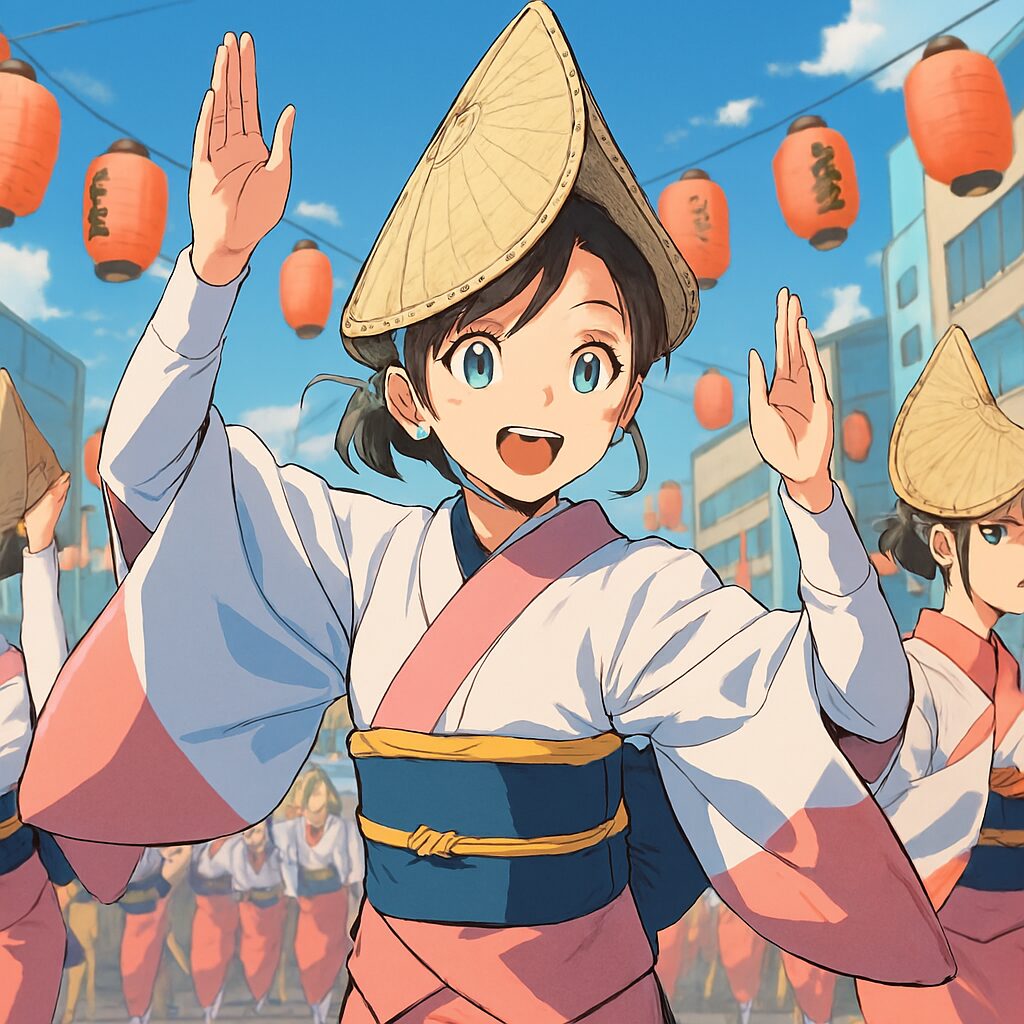- Introduction: “We’re all fools, so let’s dance!”
- What Is Awa Odori? – One of Japan’s Three Great Bon Dances
- Koenji Awa Odori – Tokushima’s Spirit in Tokyo
- Origins of Awa Odori – Castles, Commoners, and Celebration
- Dance Styles – Bold Men, Graceful Women
- Costumes and Instruments – Tradition in Motion
- The Famous Chant – “We’re All Fools, So Let’s Dance!”
- International Participation – A Global Stage
- Travel Guide – How to Enjoy Awa Odori
- The Future of Awa Odori – Tradition Meets Innovation
- Conclusion – Join the Dance, Feel the Spirit
- はじめに:踊る阿呆に見る阿呆、同じ阿呆なら踊らな損々
- 阿波おどりとは?——日本三大盆踊りのひとつ
- 高円寺阿波おどり——東京で体感する徳島の魂
- 阿波おどりの起源——徳島城と民衆の踊り
- 踊りのスタイル——男踊りと女踊りの違い
- 衣装と楽器——伝統美の融合
- 掛け声の意味——「踊る阿呆に見る阿呆」
- 海外からの参加者も増加中——国際交流の場としての阿波おどり
- 観光ガイド:阿波おどりを楽しむためのポイント
- 阿波おどりの未来——伝統と革新の融合
- まとめ:あなたも「踊る阿呆」になってみませんか?
Introduction: “We’re all fools, so let’s dance!”
Among Japan’s many summer festivals, few match the energy and joy of Awa Odori. Originating in Tokushima over 400 years ago, this traditional dance has evolved into a nationwide celebration, with Tokyo’s Koenji hosting one of the largest events outside its birthplace.
With the chant “Erai yatcha, erai yatcha, yoi yoi yoi yoi” echoing through the streets, dancers and spectators alike become part of a living rhythm. This guide explores the history, styles, costumes, and travel tips to help you experience Awa Odori to the fullest.
What Is Awa Odori? – One of Japan’s Three Great Bon Dances
Awa Odori is a traditional Bon dance from Tokushima Prefecture (formerly Awa Province). Held annually from August 12–15, the Tokushima City Awa Odori attracts over 1.2 million spectators and 100,000 dancers, making it one of Japan’s largest festivals.
Groups of dancers called ren parade through the streets to the beat of bells, drums, shamisen, and flutes. The dance is both a cultural heritage and a vibrant expression of joy.
Learn more on Wikipedia’s Awa Odori page.
Koenji Awa Odori – Tokushima’s Spirit in Tokyo
Held in late August in Tokyo’s Suginami Ward, Koenji Awa Odori began in 1957 as a local initiative to rival nearby festivals. Though it started with no trained dancers and improvised music, it grew through passion and collaboration with Tokushima’s famous Kiba Ren.
Today, it features over 5,000 dancers and draws more than a million visitors, transforming Koenji’s shopping streets into a stage of movement and music.
Visit the official Koenji Awa Odori site for details.
Origins of Awa Odori – Castles, Commoners, and Celebration
The most popular origin story dates back to 1586, when Tokushima Castle was completed. Lord Hachisuka Iemasa reportedly encouraged townspeople to celebrate freely, sparking spontaneous dancing that evolved into Awa Odori.
Other theories link it to Buddhist nenbutsu dances or medieval furyu performances. Despite bans during the Edo period and wartime interruptions, the dance survived thanks to local devotion.
Explore the history at Tokushima Net’s Awa Odori history page.
Dance Styles – Bold Men, Graceful Women
- Men’s Dance: Low stances, powerful steps, and expressive arm movements. Energetic and dynamic.
- Women’s Dance: Elegant gestures, raised heels, and refined posture. Graceful and poetic.
Each ren has its own choreography, costumes, and musical style, ranging from traditional to modern interpretations.
Costumes and Instruments – Tradition in Motion
Dancers wear yukata (summer kimono), straw hats, and tabi socks. The visual harmony of coordinated colors and patterns adds to the spectacle.
Musicians play bells (kane), drums, shamisen, and flutes, creating a hypnotic two-beat rhythm that drives the dance forward.
The Famous Chant – “We’re All Fools, So Let’s Dance!”
The iconic chant “Odoru ahou ni miru ahou, onaji ahou nara odoranya son son” translates to “The dancers are fools, the watchers are fools, so why not dance?”
It reflects a philosophy of joyful participation and letting go of self-consciousness—an invitation to join the celebration without hesitation.
International Participation – A Global Stage
- Multilingual signage and guides (English, Chinese, Korean)
- Dance workshops for foreign visitors
- Growing presence on social media and YouTube
Foreign dance teams and tourists are increasingly welcomed, making Awa Odori a symbol of cultural exchange and hospitality.
Travel Guide – How to Enjoy Awa Odori
Koenji Awa Odori (Tokyo)
- Dates: Last weekend of August
- Access: JR Koenji Station, 20 minutes from Tokyo Station
- Viewing Spots: Station rotary, Pal Shopping Street, Junjo Street
Evening hours offer the best atmosphere, with lanterns and lively crowds. Local food stalls serve Tokushima specialties like grilled Awa chicken and sudachi citrus drinks.
Tokushima City Awa Odori (Main Festival)
- Dates: August 12–15
- Access: JR Tokushima Station, walkable to venues
- Venues: Paid seating at Aibahama and Minamiuchimachi stages
Advance tickets recommended for popular ren performances. Open areas allow spontaneous dancing, and local cuisine like Naruto sweet potatoes and Tokushima ramen are must-tries.
Visit the Tokushima Tourism Association site for updates.
The Future of Awa Odori – Tradition Meets Innovation
Awa Odori continues to evolve through:
- Creative Ren: Young dancers blend hip-hop and jazz with traditional moves
- Anime Collaborations: Events like “Machi★Asobi” fuse pop culture with dance
- Digital Outreach: Instagram, TikTok, and YouTube bring the festival to global audiences
Conclusion – Join the Dance, Feel the Spirit
Awa Odori is more than a performance—it’s a celebration of life, community, and shared joy. Whether you watch or dance, you become part of its rhythm.
For travelers seeking authentic Japanese culture, unforgettable summer memories, and a chance to move with the crowd, Awa Odori offers a warm invitation: “We’re all fools, so let’s dance!”
阿波おどり完全ガイド|高円寺から徳島へ、日本の魂が踊る夏祭り
はじめに:踊る阿呆に見る阿呆、同じ阿呆なら踊らな損々
日本の夏を彩る祭りの中でも、ひときわ熱気と躍動感に満ちたもの——それが「阿波おどり」です。徳島県を発祥とするこの踊りは、400年以上の歴史を持ち、今では東京・高円寺をはじめ全国各地で開催される一大イベントとなっています。
阿波おどりとは?——日本三大盆踊りのひとつ
阿波おどりは、徳島県(旧・阿波国)を発祥とする盆踊りであり、日本三大盆踊りのひとつとして知られています。毎年8月12日〜15日に徳島市で開催される「徳島市阿波おどり」は、踊り手約10万人、観客約120万人を動員する国内最大級の祭りです。
詳しい歴史は Wikipediaの阿波踊りページ をご参照ください。
高円寺阿波おどり——東京で体感する徳島の魂
東京・杉並区の高円寺では、毎年8月下旬に「高円寺阿波おどり」が開催されます。1957年に商店街の青年部が始めたこの祭りは、今では約5,000人の踊り手と100万人以上の観客を集める東京最大級の夏祭りとなりました。
詳細は 高円寺阿波おどり公式サイト をご覧ください。
阿波おどりの起源——徳島城と民衆の踊り
阿波おどりの起源には複数の説がありますが、最も有名なのは「築城起源説」です。1586年、徳島城の完成を祝って藩主・蜂須賀家政が「好きに踊れ」と触れを出したことが始まりとされています。
歴史の詳細は とくしまnetの解説記事 が参考になります。
踊りのスタイル——男踊りと女踊りの違い
- 男踊り:腰を低く、力強く地を踏みしめる動き。勇壮でエネルギッシュ。
- 女踊り:編笠をかぶり、指先まで神経を通わせた優雅な動き。しなやかで美しい。
衣装と楽器——伝統美の融合
踊り手の衣装は浴衣・足袋・編笠などが基本。楽器は鐘(鉦)、太鼓、三味線、篠笛などが使われ、2拍子のリズムが祭りの熱気を高めます。
掛け声の意味——「踊る阿呆に見る阿呆」
この掛け声は、観客と踊り手の垣根を取り払い、誰もが祭りの一部になれるという哲学を表しています。「人生は一度きり。恥ずかしがらずに楽しもう」というメッセージが込められています。
海外からの参加者も増加中——国際交流の場としての阿波おどり
- 英語・中国語・韓国語などの案内が充実
- 外国人向けの踊り体験プログラムも開催
- SNSでの発信により世界中にファンが拡大
観光ガイド:阿波おどりを楽しむためのポイント
高円寺阿波おどり(東京)
- 開催時期:8月下旬の土日
- アクセス:JR高円寺駅から徒歩すぐ
- 観覧ポイント:駅前ロータリー、パル商店街など
最新情報は 公式サイト をご確認ください。
徳島市阿波おどり(本場)
- 開催時期:8月12日〜15日
- アクセス:JR徳島駅から徒歩圏内
- 演舞場:藍場浜演舞場、南内町演舞場など
詳細は 徳島市観光協会公式サイト をご覧ください。
阿波おどりの未来——伝統と革新の融合
若者による創作連の登場、アニメ・ゲームとのコラボレーション、SNSによる発信など、阿波おどりは常に進化を続けています。
まとめ:あなたも「踊る阿呆」になってみませんか?
阿波おどりは、見るだけでも楽しいですが、踊ることでその魅力が何倍にも広がります。日本の文化に触れたい方、夏の思い出を作りたい方、ぜひ一度、阿波おどりの世界に足を踏み入れてみてください。



コメント